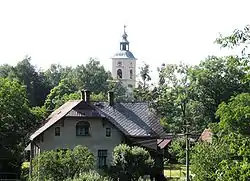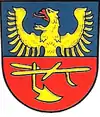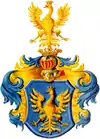Komorní Lhotka
![]() Komorní Lhotka (Polish:
Komorní Lhotka (Polish: ![]() Ligotka Kameralna, German: Kameral Ellgoth) is a municipality and village in Frýdek-Místek District in the Moravian-Silesian Region of the Czech Republic. It has about 1,400 inhabitants. Polish minority makes up 14.9% of the population.[2] It lies in the historical region of Cieszyn Silesia.
Ligotka Kameralna, German: Kameral Ellgoth) is a municipality and village in Frýdek-Místek District in the Moravian-Silesian Region of the Czech Republic. It has about 1,400 inhabitants. Polish minority makes up 14.9% of the population.[2] It lies in the historical region of Cieszyn Silesia.
Komorní Lhotka
Ligotka Kameralna | |
|---|---|
 A view of Komorní Lhotka | |
 Flag  Coat of arms | |
 Komorní Lhotka Location in the Czech Republic | |
| Coordinates: 49°39′29″N 18°31′40″E | |
| Country | |
| Region | Moravian-Silesian |
| District | Frýdek-Místek |
| First mentioned | 1455 |
| Area | |
| • Total | 19.88 km2 (7.68 sq mi) |
| Elevation | 410 m (1,350 ft) |
| Population (2020-01-01[1]) | |
| • Total | 1,420 |
| • Density | 71/km2 (180/sq mi) |
| Time zone | UTC+1 (CET) |
| • Summer (DST) | UTC+2 (CEST) |
| Postal code | 739 53 |
| Website | www |
Etymology
Lhotka and Ligotka are diminutive forms of Lhota in Czech and Ligota in Polish respectively, which are common names for villages in both Czech Republic and Western Poland. The word refers to the medieval custom of village founders being exempt from paying duties to their lords for a period of 5–8 years. As it is a common name it is often accompanied by an distinguishing adjective. Komorní Lhotka was first mentioned as Buczkowa Lhota, where Buczkowa was an adjective derived from personal name Buczek (in contrary to what might seem from beech trees, Czech and Polish: buk). Later the adjective was replaced or dropped and eventually in the 19th century it became known as Komorní (Polish: Kameralna and German Cammeral) as it was belonging to Teschener Kammer.[3]
History
Komorní Lhotka was first mentioned in 1455 as Buczkowa Lhota.[3][4]
Politically the village belonged initially to the Duchy of Teschen, formed in 1290 in the process of feudal fragmentation of Poland and was ruled by a local branch of Piast dynasty. In 1327 the duchy became a fee of the Kingdom of Bohemia, which after 1526 became part of the Habsburg Monarchy.
After the 1540s Reformation prevailed in the Duchy of Teschen and many local citizens became Lutherans. After issuing the Patent of Toleration in 1781 they subsequently organized a local Lutheran parish as one of over ten in the region.[5]
After Revolutions of 1848 in the Austrian Empire a modern municipal division was introduced in the re-established Austrian Silesia. The village as a municipality was subscribed to the political and legal district of Cieszyn. According to the censuses conducted in 1880, 1890, 1900 and 1910 the population of the municipality dropped from 1,164 in 1880 to 1,038 in 1910 with a majority being native Polish-speakers (99.2%-100%) accompanied by a small German-speaking minority (at most 12 or 1.3% in 1880) and occasionally 1 Czech-speaking person. In terms of religion in 1910 the majority were Protestants (88.2%), followed by Roman Catholics (11.2%), Jews (3 people) and also 3 people adhering to another faiths.[6] The village was also traditionally inhabited by Cieszyn Vlachs, speaking Cieszyn Silesian dialect.
After World War I, fall of Austria-Hungary, Polish–Czechoslovak War and the division of Cieszyn Silesia in 1920, it became a part of Czechoslovakia. Following the Munich Agreement, in October 1938 together with the Zaolzie region it was annexed by Poland, administratively adjoined to Cieszyn County of Silesian Voivodeship.[7] It was then annexed by Nazi Germany at the beginning of World War II. After the war it was restored to Czechoslovakia.
Spa
Since 1860 Kamenná Lhotka is known for its minor spa, using herbal baths for treating problems with back and cervical vertebrae.[8]
References
- "Population of Municipalities – 1 January 2020". Czech Statistical Office. 30 April 2020.
- "Public database: Census 2011". Czech Statistical Office. Retrieved 21 November 2020.
- Mrózek, Robert (1984). Nazwy miejscowe dawnego Śląska Cieszyńskiego [Local names of former Cieszyn Silesia] (in Polish). Katowice: University of Silesia in Katowice. pp. 105–106. ISSN 0208-6336.
- Panic, Idzi (2010). Śląsk Cieszyński w średniowieczu (do 1528) [Cieszyn Silesia in Middle Ages (until 1528)] (in Polish). Cieszyn: Starostwo Powiatowe w Cieszynie. p. 309. ISBN 978-83-926929-3-5.
- Michejda, Karol (1992). "Dzieje Kościoła ewangelickiego w Księstwie Cieszyńskim (od Reformacji do roku 1909)". Z historii Kościoła ewangelickiego na Śląsku Cieszyńskim (in Polish). Katowice: Dom Wydawniczy i Księgarski „Didache“. pp. 143–144. ISBN 83-85572-00-7.
- Piątkowski, Kazimierz (1918). Stosunki narodowościowe w Księstwie Cieszyńskiem (in Polish). Cieszyn: Macierz Szkolna Księstwa Cieszyńskiego. pp. 263, 281.
- "Ustawa z dnia 27 października 1938 r. o podziale administracyjnym i tymczasowej organizacji administracji na obszarze Ziem Odzyskanych Śląska Cieszyńskiego". Dziennik Ustaw Śląskich (in Polish). Katowice. nr 18/1938, poz. 35. 31 October 1938. Retrieved 1 July 2014.
- "O Bylinných lázničkách" (in Czech). Bylinné lázničky, s.r.o. Retrieved 21 November 2020.

